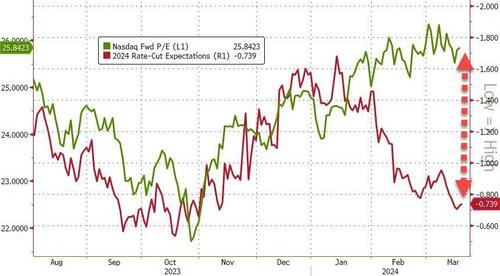Credit Markets May Be More Sensitive To Fed Dot-Plot Than Rates
Authored by Ven Ram, Bloomberg cross-asset strategist,
The Federal Reserve may be the biggest game in town, but someone forgot to tell credit and stock markets.
Treasuries slumped over the past two weeks as concerns grew about potential dot-plot shifts, but credit investors paint a picture of studied nonchalance. US investment-grade corporate bonds offer a scant 89 basis points above 10-year Treasuries, the lowest in more than two years.
Stocks, of course, have behaved for some time as if interest rates don’t matter for valuations. Which is why, despite the recent selloff in Treasuries, financial conditions are near the loosest they have been since 2021 — that is, before the Fed started raising rates in this cycle.
In effect, whether or not the US shows shows its hand on how near its de jure rate cuts may be, the markets are acting as if policymakers already more than delivered those reductions de facto.
That means the impact from a hawkish Fed today will be felt far more acutely in parts of the markets other than Treasuries.
Treasuries, of course, have convulsed in recent days on fears that the Fed may take back one of the three rate cuts it has indicated for this year. That means the fallout for rates may be sharply asymmetric, with any perceived dovishness likely to spur bigger moves than any moves to raise the dot plot.
That apart, a veritable shock for the markets would be what the Fed projects as its longer-run funds rate. The central bank has traditionally used a 2.50% estimate, implicitly invoicing a real neutral rate of 50 basis points.
Recent estimates have pegged this nirvana rate higher, so a revision higher for the longer-run funds rate would be an acknowledgement of that and shake up Treasuries. However, I expect the possibility of such a revision to be extremely slim.
Of great interest today will also be any discussion within the Fed that centered on the continued unwind of its balance sheet, with markers of excess liquidity in the financial system careening lower and lower to levels that prevailed in 2021.
Tyler Durden
Wed, 03/20/2024 – 08:05
via ZeroHedge News https://ift.tt/rwXmSNH Tyler Durden


